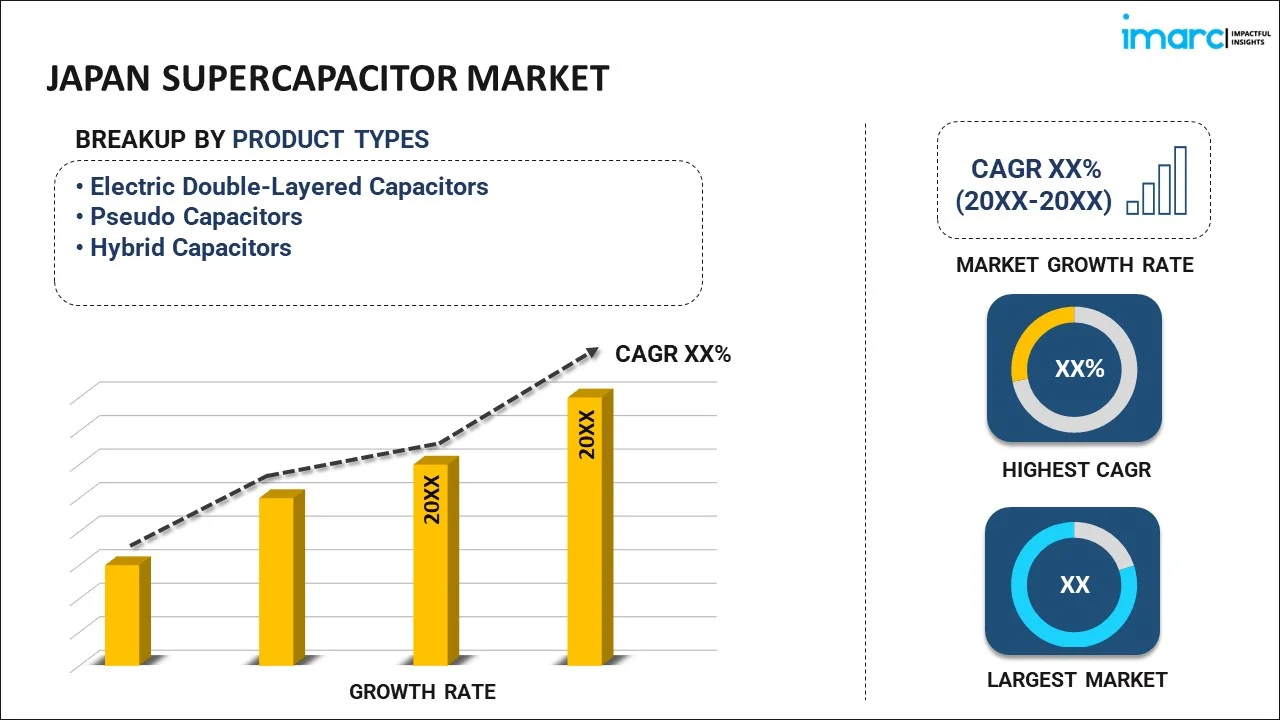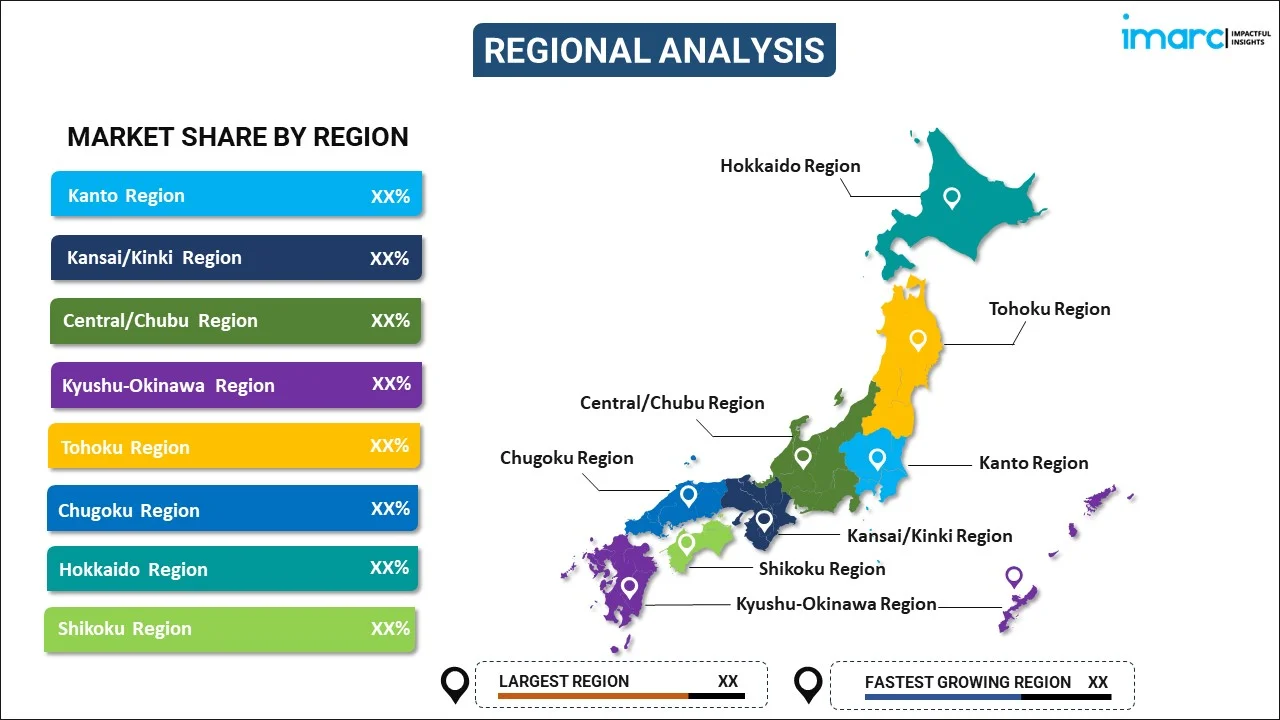
Japan Supercapacitor Market Report by Product Type (Electric Double-Layered Capacitors, Pseudo Capacitors, Hybrid Capacitors), Module Type (Less than 25V, 25-100V, More than 100V), Material Type (Carbon and Metal Oxide, Conducting Polymer, Composite Materials), End Use Industry (Automotive and Transportation, Consumer Electronics, Power and Energy, Healthcare, and Others), and Region 2025-2033
Market Overview:
Japan supercapacitor market size reached USD 379.0 Million in 2024. Looking forward, IMARC Group expects the market to reach USD 1,120.0 Million by 2033, exhibiting a growth rate (CAGR) of 12.8% during 2025-2033. The emerging shift towards electric vehicles and hybrid electric vehicles, that require high-power density and fast charging/discharging capabilities, is primarily driving the supercapacitor market.
|
Report Attribute
|
Key Statistics
|
|---|---|
|
Base Year
|
2024 |
|
Forecast Years
|
2025-2033
|
|
Historical Years
|
2019-2024
|
| Market Size in 2024 | USD 379.0 Million |
| Market Forecast in 2033 | USD 1,120.0 Million |
| Market Growth Rate (2025-2033) | 12.8% |
A supercapacitor, also known as an ultracapacitor or electrochemical capacitor, is an energy storage device that bridges the gap between traditional capacitors and batteries. Unlike standard capacitors, which store energy electrostatically, supercapacitors store energy through electrochemical processes. They consist of two porous electrodes separated by an electrolyte, with a high surface area that allows for the rapid accumulation and release of electrical charge. Supercapacitors offer several advantages, including fast charging and discharging, high power density, and a long cycle life. They are ideal for applications requiring bursts of power, such as regenerative braking systems in hybrid vehicles, elevators, and renewable energy systems. Supercapacitors can complement or even replace batteries in some applications, providing quick energy bursts when needed. However, they typically have lower energy density than batteries, which makes them less suitable for long-term energy storage. Ongoing research seeks to enhance supercapacitor technology to increase their energy density and broaden their applications in various industries, including electronics, transportation, and renewable energy.
Japan Supercapacitor Market Trends:
The supercapacitor market in Japan is witnessing robust growth, primarily driven by a myriad of factors. Firstly, the increasing demand for renewable energy sources has positioned supercapacitors as a preferred choice due to their rapid charge-discharge capabilities and long cycle life. Additionally, with the rise in the proliferation of electronics and the need for efficient power management in devices, the utilization of supercapacitors has become inevitable. Notably, the automotive sector serves as a significant propellant for this growth, as electric vehicles and hybrid electric vehicles are increasingly relying on supercapacitors for better performance and extended battery life. Moreover, advancements in nanotechnology have paved the way for the development of more advanced and efficient supercapacitors, further spurring their adoption across various industries. Another compelling factor is the push for sustainable and environmentally friendly energy storage solutions, of which supercapacitors form a vital part. Furthermore, the declining cost of materials and production, combined with supportive government policies, has further catalyzed the market's expansion. In essence, the supercapacitor market in Japan is set on a trajectory of significant growth, underpinned by technological advancements and the overarching theme of sustainability.
Japan Supercapacitor Market Segmentation:
IMARC Group provides an analysis of the key trends in each segment of the market, along with forecasts at the country level for 2025-2033. Our report has categorized the market based on product type, module type, material type, and end use industry.
Product Type Insights:

- Electric Double-Layered Capacitors
- Pseudo Capacitors
- Hybrid Capacitors
The report has provided a detailed breakup and analysis of the market based on the product type. This includes electric double-layered capacitors, pseudo capacitors, and hybrid capacitors.
Module Type Insights:
- Less than 25V
- 25-100V
- More than 100V
A detailed breakup and analysis of the market based on the module type have also been provided in the report. This includes less than 25V, 25-100V, and more than 100V.
Material Type Insights:
- Carbon and Metal Oxide
- Conducting Polymer
- Composite Materials
The report has provided a detailed breakup and analysis of the market based on the material type. This includes carbon and metal oxide, conducting polymer, and composite materials.
End Use Industry Insights:
- Automotive and Transportation
- Consumer Electronics
- Power and Energy
- Healthcare
- Others
A detailed breakup and analysis of the market based on the end use industry have also been provided in the report. This includes automotive and transportation, consumer electronics, power and energy, healthcare, and others.
Regional Insights:

- Kanto Region
- Kansai/Kinki Region
- Central/ Chubu Region
- Kyushu-Okinawa Region
- Tohoku Region
- Chugoku Region
- Hokkaido Region
- Shikoku Region
The report has also provided a comprehensive analysis of all the major regional markets, which include Kanto Region, Kansai/Kinki Region, Central/ Chubu Region, Kyushu-Okinawa Region, Tohoku Region, Chugoku Region, Hokkaido Region, and Shikoku Region.
Competitive Landscape:
The market research report has also provided a comprehensive analysis of the competitive landscape. Competitive analysis such as market structure, key player positioning, top winning strategies, competitive dashboard, and company evaluation quadrant has been covered in the report. Also, detailed profiles of all major companies have been provided.
Japan Supercapacitor Market Report Coverage:
| Report Features | Details |
|---|---|
| Base Year of the Analysis | 2024 |
| Historical Period | 2019-2024 |
| Forecast Period | 2025-2033 |
| Units | Million USD |
| Scope of the Report | Exploration of Historical Trends and Market Outlook, Industry Catalysts and Challenges, Segment-Wise Historical and Future Market Assessment:
|
| Product Types Covered | Electric Double-Layered Capacitors, Pseudo Capacitors, Hybrid Capacitors |
| Module Types Covered | Less than 25V, 25-100V, More than 100V |
| Material Types Covered | Carbon and Metal Oxide, Conducting Polymer, Composite Materials |
| End Use Industries Covered | Automotive and Transportation, Consumer Electronics, Power and Energy, Healthcare, Others |
| Regions Covered | Kanto Region, Kansai/Kinki Region, Central/ Chubu Region, Kyushu-Okinawa Region, Tohoku Region, Chugoku Region, Hokkaido Region, Shikoku Region |
| Customization Scope | 10% Free Customization |
| Post-Sale Analyst Support | 10-12 Weeks |
| Delivery Format | PDF and Excel through Email (We can also provide the editable version of the report in PPT/Word format on special request) |
Key Questions Answered in This Report:
- How has the Japan supercapacitor market performed so far and how will it perform in the coming years?
- What has been the impact of COVID-19 on the Japan supercapacitor market?
- What is the breakup of the Japan supercapacitor market on the basis of product type?
- What is the breakup of the Japan supercapacitor market on the basis of module type?
- What is the breakup of the Japan supercapacitor market on the basis of material type?
- What is the breakup of the Japan supercapacitor market on the basis of end use industry?
- What are the various stages in the value chain of the Japan supercapacitor market?
- What are the key driving factors and challenges in the Japan supercapacitor?
- What is the structure of the Japan supercapacitor market and who are the key players?
- What is the degree of competition in the Japan supercapacitor market?
Key Benefits for Stakeholders:
- IMARC’s industry report offers a comprehensive quantitative analysis of various market segments, historical and current market trends, market forecasts, and dynamics of the Japan supercapacitor market from 2019-2033.
- The research report provides the latest information on the market drivers, challenges, and opportunities in the Japan supercapacitor market.
- Porter's five forces analysis assist stakeholders in assessing the impact of new entrants, competitive rivalry, supplier power, buyer power, and the threat of substitution. It helps stakeholders to analyze the level of competition within the Japan supercapacitor industry and its attractiveness.
- Competitive landscape allows stakeholders to understand their competitive environment and provides an insight into the current positions of key players in the market.
Need more help?
- Speak to our experienced analysts for insights on the current market scenarios.
- Include additional segments and countries to customize the report as per your requirement.
- Gain an unparalleled competitive advantage in your domain by understanding how to utilize the report and positively impacting your operations and revenue.
- For further assistance, please connect with our analysts.
 Inquire Before Buying
Inquire Before Buying
 Speak to an Analyst
Speak to an Analyst
 Request Brochure
Request Brochure
 Request Customization
Request Customization




.webp)




.webp)












